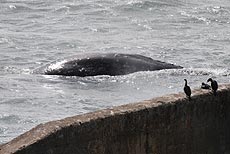 |
Oregon Coast Recreation Report: Birds, Whales, Tides and a Solar Eclipse
Published 05/18/2012

(Oregon Coast) – For those looking for whales, birds, tide pool creatures at low tides and even funky amphibians, the Oregon coast has got some prime viewing possibilities. For this weekend's solar eclipse: not so much. (Above: Yachats)
The annular eclipse of the sun is coming up on Sunday. In northwest Oregon, including Portland and the north coast, it peaks at 6:21 p.m. According to most weather forecasts, the coast will be mostly cloudy to overcast and somewhat rainy on that day – although forecasters are differing in their predictions. Apparently, you'll have better luck to spot this astronomical occurrence inland, around Portland, Salem, Eugene or Medford.
In southern Oregon, more of the sun will be covered than in the northern half.
All is not lost, however. Because it is the Oregon coast, it will likely mean plenty of gaps between the clouds, so you should be able to catch at least some of the solar eclipse.
Do NOT stare at the eclipse with the naked eye. For viewing tips and safety.
Oregon Department of Fish and Wildlife issued a report for current conditions on many opportunities to catch wildlife along the beaches.
State officials say gray whales are on their way back up this way.
 |
| Tide pool delights near Florence and Yachats |
“The first of Oregon’s more than 200 resident gray whales are returning from their breeding grounds in Mexico’s Sea of Cortez,” ODFW said. “They stay along the Oregon coast during the summer. Gray whale mothers and calves, the last of the northern migrants, are still meandering north.”
The Whale Watch Center in Depoe Bay has reported seeing between 10 and 12 whales on many days in the last couple of weeks.
For birds, ODFW said shore birds are putting quite the show in the bays and estuaries of the Oregon coast. Mud flats will be your best bet to spot them – such as around Newport, Waldport, Yachats, Seaside, Astoria and the Nehalem Bay area. Tens of thousands stop to feed in these environments as they head to breeding grounds in the south.
Migratory song birds start showing up in May as well.
About now you'll notice a lot of frog noises at night. ODFW said amphibians are hatching all over wetlands on the coast.
“The best time to visit a wetland is around dusk,” ODFW said. “Listen for red legged and Pacific chorus frogs.”
 |
| Gray whales at Depoe Bay - courtesy Whale Watch Center |
More big minus tides are happening right now. Until May 26, a rather large minus tide series happens in the mornings. Minus two inches to minus one-foot tides will be common, with many minus ten inches predicted through those nine days.
“Look for green anemones, hermit crabs, sea urchins, small fish, jelly fish, sea stars, pinkish corraline algae, lime green anemone, dark green sea lettuce, barnacles and other animals of the intertidal region,” ODFW said.
ODFW suggests poking around Haystack Rock and Hug Point around Cannon Beach, Seal Rock, Strawberry Hill, Neptune State Park, Yachats, Yaquina Head at Newport and places on the southern Oregon coast such as Cape Arago, Sunset Bay or Cape Blanco, among others.
Keep safety in mind, however.
“Don’t turn your back on the ocean because a large wave may get you wet or worse,” ODFW said. “Also, stay off beach logs. They can roll in the surf and crush you. High surf can make tide pooling on the ocean beaches uncomfortable and dangerous, so try looking for wildlife in the mud flats of coastal bays and rivers. For more information see: http://www.dfw.state.or.us/MRP/shellfish/bayclams/watchable.asp
Below: birds near Florence

More About Oregon Coast hotels, lodging.....
More About Oregon Coast Restaurants, Dining.....
 |
 |
 |
Keywords: whales, birds, cape kiwanda, topography, biology, astronomy, Pacific City, Cannon Beach, Yachats, Depoe Bay, Newport, Lincoln City, Manzanita, Oceanside, Astoria, Oregon coast, science.
LATEST OREGON COAST NEWS STORIES
Oregon Coast, Valley and Likely Washington Coast to Get Some Aurora Borealis ... |
Back to Oregon Coast
Contact Advertise on BeachConnection.net
All Content, unless otherwise attributed, copyright BeachConnection.net Unauthorized use or publication is not permitted
Secrets of the Season |
Unusual Travel Articles TravelParanormal.com allows you to submit your own creepy tale or debunk one - or see up-to-the-minute news headlines about travel and the paranormal. News Headlines from All Over Oregon Need to scan Oregon headlines? Constantly updated news from all over Oregon: a comprehensive, up-to-the-minute display of news headlines from a variety of media |




































